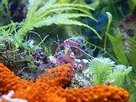Harlequin Shrimp - Hymenocera picta

Taxonomy:
Harlequin Shrimp belongs to the Kingdom Animalia, Phylum Arthropoda, Class Crustacea, Order Decapoda, Family Gnathophyllidae, Genus Hymenocera and Species picta.
Scientific names:
The scientific name of Harlequin Shrimp is Hymenocera picta.
Other common names:
Harlequin Shrimp is also commonly known as Painted Dancing Shrimp, Eastern Harlequin Shrimp, Clown Shrimp and Dancing Shrimp.
Origin or natural range:
Hymenocera picta originates from the tropical Indo-Pacific region.
Size:
Harlequin Shrimp may grow up to a size of 1.0 inch to 1.50 inches with males being smaller than their female counterparts.
Color:
Hymenocera picta occurs in brown, tan, blue, white, purple, cinnamon and red colors.
Compatibility:
Harlequin Shrimp is non-aggressive towards the other marine aquarium members.
Habit & Habitat:
- Hymenocera picta is generally found in pairs.
- Harlequin Shrimp is non-poisonous in nature.
- Hymenocera picta is nocturnal in its habit and therefore, feeds at night.
- The white colored body of Harlequin Shrimp is largely spotted in pink, orange or red colors with each spot being outlined in purple color to make the shrimp beautiful to look at.
- The abdominal legs of females have blue colored tips while, that of males are transparent.
- The first pair of legs of Hymenocera picta is developed into large tapering claws, called Chelipedes, which have no utility. The second pair of legs covers the first pair.
- The first pair of antennae of Harlequin Shrimp is shaped like a flap or a leaf.
- The eyes of Hymenocera picta are stalked.
- Temperature of water: Seventy-two to seventy-eight degrees Fahrenheit.
- Specific gravity of water: 1.023 to 1.025.
- pH of water: 8.10 to 8.40.
- Illumination: Harlequin Shrimp requires moderate illumination in the marine aquarium it inhabits.
- Habit & habitat: To host Hymenocera picta, you should have a reef type marine aquarium having corals, rocks and vegetation.
- Keep single or a mating pair of Harlequin Shrimp in your marine aquarium.
- Feeding & Nutrition: Hymenocera picta is Carnivorous in feeding habit and eats the tube feet of Echinoderms only such as, Starfish, etc and Sea Urchins. Adult Harlequin Shrimp eats the starfish Asterias rubens, Comet and Blood Spotted Starfish, while, the young ones of the shrimp eat the starfish Linckia and Chocolate Chip Starfish.
- Hymenocera picta begins eating the starfish from its arms progressing towards its centre. In response, starfish may shed its hurt hand but in the process, may get wounded lethally.
- Benefits: Asterina Star is a Starfish that has around three to five randomly shaped legs. Asterina Star eats corals and if you want to regulate or free your marine aquarium off the starfish then, introduce Harlequin Shrimp into the same tank. The shrimp will eat away all the Asterina Stars present in your aquarium.
- Harlequin Shrimp needs moderate care and should be handled by expert aquarists only.
- Copper Sulphate and Nitrates in your marine aquarium may prove fatal for Hymenocera picta.
- Add Iodine as the dietary supplement for Harlequin Shrimp to smoothen up its molting process.

Cleaner Shrimp - Lysmata amboinensis - Cleaner Red Skunk Shrimp - White-Striped Cleaner Shrimp
Freshmarine: $29.98
You Save 23.11%
Fire Shrimp - Lysmata debelius - Scarlet Cleaner Shrimp - Blood Shrimp - Fire Shrimp
Freshmarine: $43.98
You Save 37.16%
Glass Anemone Shrimp - Periclimenes brevicarpalis - Pacific Clown Anemone Shrimp
Freshmarine: $19.95
You Save 31.18%
Before Placing Your Order
Store InformationShipping Info
Payment Info
Return Policy
Arrive Alive Guarantee
Adoptation Policy
After Placing Your Order
Track Your OrderSecurity Safe Shopping
Compatibility Chart
Shoppers Review










